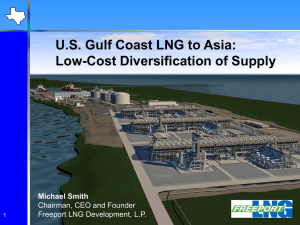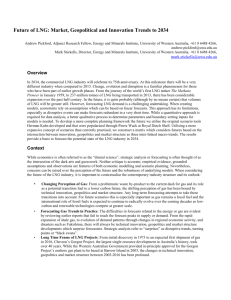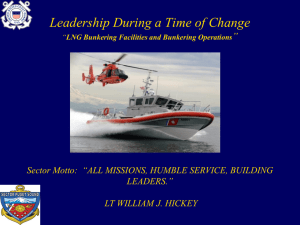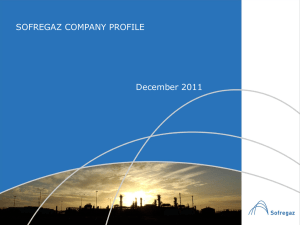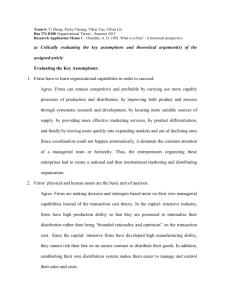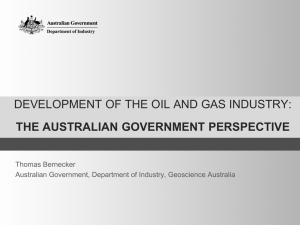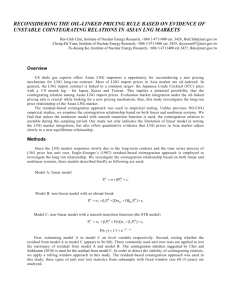Policies for the Reduction of Slash Pile Burning in BC Forests
advertisement
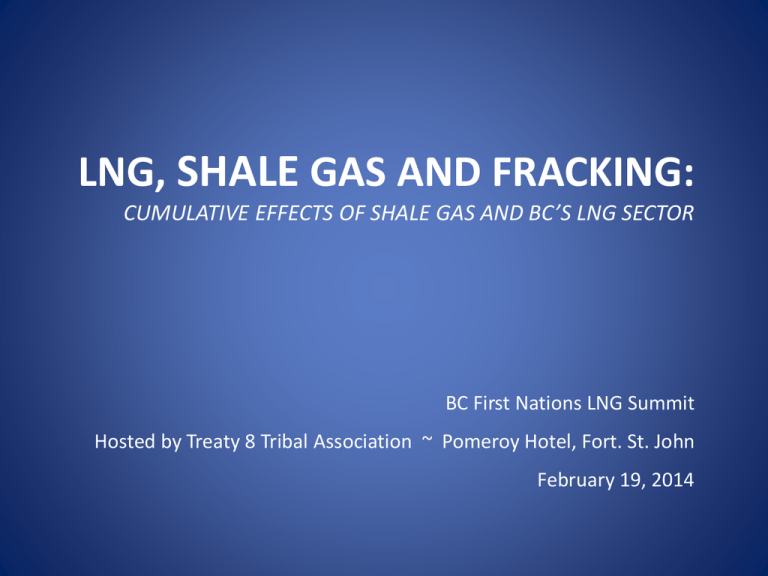
LNG, SHALE GAS AND FRACKING: CUMULATIVE EFFECTS OF SHALE GAS AND BC’S LNG SECTOR BC First Nations LNG Summit Hosted by Treaty 8 Tribal Association ~ Pomeroy Hotel, Fort. St. John February 19, 2014 Who we are ~ We are a Dene & Cree community in NE BC ~ 800 members ~ Our vision: A nation, a people—strong, healthy and self-reliant ~ Our families wish to continue to provide for ourselves in our own land long into the future 2 FNFN is a Treaty Nation ~ Treaty 8 confirms our right to govern our traditional territory, ‘nation-to-nation’ ~ Governance = the right and responsibility to protect and manage our territory for our future generations ~ A central role in economic development and resource management is a treaty imperative 3 Shale Gas Plays in FNFN Territory 4 5 6 Summary of Gas-Related Activity Horn River Basin Liard Basin Cordova Embayment % tenured by 2012 63.5% 18.4% 44.6% Linear disturbance 2002-2012 (density on tenure) 59,915 km (6.84 km/km2) 7137 km (1.07 km/km2) 11,531 km (5.93 km/km2) Areal disturbance on tenure, 2012 (with 250m buffer on lines) 71% of tenured lands 33% of tenured lands 73% of tenured lands Gas wells drilled 20072012 537 39 53 Well pads constructed 2007-2012 255 32 22 Production rates Dec. 2011 400 million cubic feet/day Minimal 200 million cubic feet/day *All data from OGC sources 7 Cumulative Effects of Shale Gas Significant impacts affecting: ~ Land ~ Water ~ Air 8 Impacts to Land: Linear Disturbance ~ Pipelines, seismic & roads ~ Habitat fragmentation ~ Predator – Prey balance disrupted ~ Damage to streams during crossing ~ Interference with FNFN access to traditional lands ~ Taking up of land 9 Impacts on the Land: Roads ~ Increased speed and traffic pollution, dust, garbage and noise ~ Wildlife mortality including beaver “relocation” ~ Sand and gravel quarries ~ Increased access to FNFN hunting areas ~ Our people feel unwelcome and unsafe in our own land Impacts on the Land: Well Pads ~ Sites will checkerboard landscape every 2 to 6 km ~ Industry term: “carpet bomb” ~ Enlarged 200m x 200m sites to accommodate frack crews ~ Dust, noise, weeds, erosion, run-off, spills ~ Loss of land for traditional use ~ Contamination of surrounding ecosystem 11 Impacts on the Land: Deforestation ~ Oil and Gas companies are exempt from using merchantable timber because the mill is too far away ~ Solution is to burn all trees Impacts on the Land: Frack Sand Mining ~ Frack (silica) sand exploration coincides with good Caribou habitat ~ Frack sand mining will require processing plants ~ silica sand has been implicated in causing silicosis, a lung disease ~ it can take up to 10,000 tons of silica sand to frack one well Impacts on Water: Contamination ~ Fluids used in fracking are known carcinogens ~ Our people are afraid to drink from the land ~FNFN members worry for the health of the animals and plants ~Tu ni ttheh—We need the Water 14 Impacts on Water: The Water Cycle ~ Huge water withdrawal and loss ~ Our people fear that the muskeg will be “dried up” because the water is taken forever ~ Our people fear that there will be no beaver, moose, fish or other foods & medicines that we need 15 Impacts on Air ~ Members report changes in air quality ~ Avoidance of food and medicine plants and snow ~ Health concerns (e.g. sour gas leaks) ~ Climate impacts of CO2 extraction and venting 16 Gas Processing = GHG Emissions Enbridge’s Cabin Gas Plant –1 of 5–will release 200 million tonnes of CO2 into the atmosphere every year. BC just permitted the Fortune Creek Gas Plants, which will raise BC’s GHG emissions another 3.5% through direct venting of CO2 to the environment BC’s LNG Strategy Upstream gas basins Midstream pipelines LNG facilities 18 BC’s LNG Strategy: The Promise ~ BC LNG strategy is “moving ahead without delay” ~ $1 trillion to be generated between 2013 - 2046 ~ “new money” that serves as a legacy for all British Columbians ~ BC is “continuing close work with industry and First Nations to build world’s cleanest LNG industry” 19 Photo Source: BC Energy and Mines, Liquefied Natural Gas: A Strategy for B.C.’s Newest Industry BC’s LNG Strategy: The Peril ~ Race is on to develop LNG export facilities on the BC coast ~ No final investment decisions made ~ BC is pitching economic benefits while ignoring environmental costs ~ Upstream impacts and First Nations have been ignored by Crown, regulators and industry in LNG debate http://www.gov.bc.ca/com/attachments/LNGreport_update2013_web130207.pdf 20 Cumulative Effects of BC’s LNG Strategy A projection of BC’s LNG Strategy shows that the number of shale gas wells drilled and fracke in FNFN territory will increase by 600% over the next 20 years. 3500 3000 2500 2000 1500 1000 500 0 2007-2012 2014-2034 (LNG) 21 Cumulative Effects of BC’s LNG Strategy Given current LNG proposals, we expect LNG to induce: • 3,000 new wells in FNFN territory • 300 new large industrial facilities • 50,000 km of seismic lines • 4,500 km of new roads • 1000’s of new water permits for fracking 22 Cumulative Effects of BC’s LNG Strategy Land ~ tens of thousands of kilometers of roads, seismic lines & pipelines ~ thousands of well pads, frack sand mines, camps, plants & borrow pits Water ~ trillions of litres of water removed from muskeg, rivers and lakes ~ waste water blowouts, leaks and spills Air ~ Increasing pollution and emissions 23 BC Cumulative Effects Framework • Outdated LRMP sets values & objectives • First Nations not involved in values identification • No mandate for LUPs, thresholds, “red colour” areas or monitoring • NE Pilot irrelevant to FNFN 24 FNFN Approach to Cumulative Effects Assessment ~ Uphold our treaty ~ Establishment of territorial monitoring systems ~ Collection of ‘baseline data’ ~ Shared decision making on the ground and at strategic level ~ Basis for our decision-making is FNFN values and objectives 25 Mussi cho (big thank you) Sah lo Dene (for all our relations) Please join us in the Fort Nelson First Nation Territory April 14-16, 2014 27

